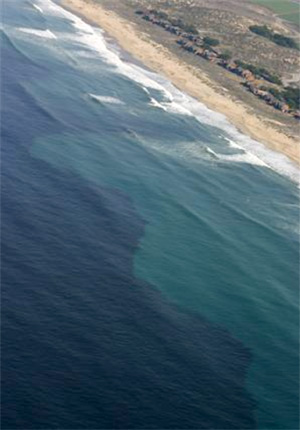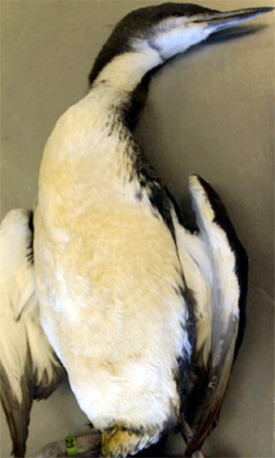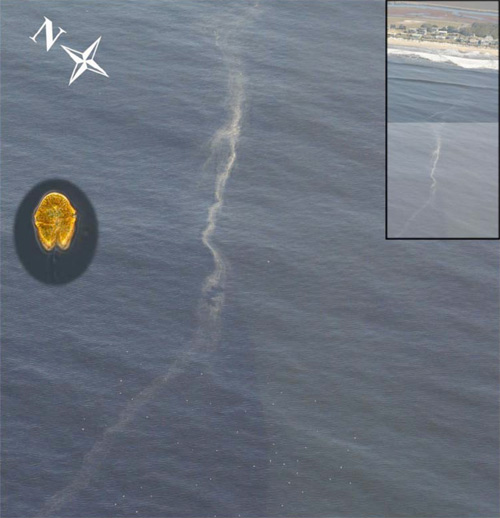
When hundreds of dead and stranded seabirds began to appear on the beaches of Monterey Bay in 2007, biologists began investigating the cause of the unusual phenomenon. The only concrete piece of evidence was a yellow-green stain on the breast feathers of many of the birds. There was speculation that the Cosco Busan oil spill, which occurred on November 7th, 2007 and resulted in 58,000 gallons of fuel being released into San Francisco Bay, was the culprit. Others hypothesized a link to the use of pesticides deployed from aircraft on the Central Coast intended to eradicate the brown apple moth. In the end however, biologists concluded that microscopic plankton were responsible for the mass-stranding event. The dominant species in the algal bloom responsible was a dinoflagellate known to science as Akashiwo sanguinea. While red algal blooms have been linked with other mass-stranding events of marine mammals as a result of toxins produced by the algae (most notably domoic acid), the dead and stranded seabirds showed no signs of having been exposed to biotoxins. Moreover, A. sanguiea blooms have occurred in the past without deleterious effects on wildlife. Further investigation revealed that the dinoflagellate produced a protein that acted like a detergent, which dissolved the natural oils in the feathers of seabirds. Large waves exacerbated the problem by breaking apart dead algae cells, releasing more of the surfactant. These natural oils repel water, allowing seabirds to float and stay warm and dry. Consequently, seabirds that came into contact with the surfactant were unable to fly or hunt and starved to death, or they succumbed to hypothermia when their feathers became inundated with water.
A total of 550 birds were collected alive, while 207 were found dead.

The Monterey Bay Sanctuary Beach COMBERS (Coastal Ocean Mammal and Bird Education and Research Surveys), a collaborative volunteer research organization, was responsible for finding many of the dead and stranded seabirds. Data collected by Beach COMBERS was instrumental in solving this unusual case. In addition, many of the seabirds that the volunteers found were sent to local animal care centers and were released back into the wild following successful rehabilitation.
Algal blooms may occur when nutrients from rivers or estuaries enter the ocean in excessive amounts. The excess nutrients may be anthropogenic (i.e., run-off from farms and cities) or natural (i.e., coastal upwelling). As a result of an overabundance of nutrients required for growth and reproduction, such as nitrogen and phosphorus, algae such as A. sanguiea may rapidly reproduce and accumulate. Algal blooms are often harmless but other times they may lead to anoxia after they die and decompose, generate biotoxins, or produce surfactants that strip seabirds of their natural weather-proofing. The latter is a relatively new phenomenon to science, having never been previously recorded; however, it is possible that similar stranding events may have occurred entirely unnoticed. Algal blooms that have deleterious effects on humans or wildlife are known as Harmful Algal Blooms (HABs). The occurrence of algal blooms, harmless or otherwise, may be increasing in size and frequency due to increasing human activities and global climate change. In past 5 years, incidences of algal blooms and powerful waves have been on the rise on the California Coast, but in order to better predict the occurrence of HABs, the linkages between natural processes and human activities must be better understood.

|
|